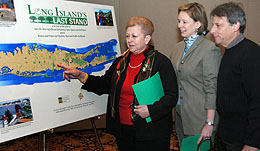Jacobs endorses ‘Last Stand’ for Long Island’s environment
Initiative aims to preserve Long Island’s quality of life
January 11, 2006
Nassau County Presiding Officer Judy Jacobs (D-Woodbury) joined today with a coalition of over 100 concerned environmental, civic and business associations, as well as elected officials from Nassau and Suffolk counties, to support Long island's Last Stand, a 10-year action plan to save the most significant remaining open spaces and farmland and to restore and protect Long Island's harbors, bays and public parklands.
 |
| Pictured, left to right: Presiding Officer Judy Jacobs (D-Woodbury), Lisa Ott of the North Shore Land Alliance, and President of the East Norwich Civic Association Matthew Meng, joined with a coalition of over 100 concerned environmental, civic and business associations, as well as elected officials from Nassau and Suffolk counties, to support Long island’s Last Stand, a 10-year action plan to save the most significant remaining open spaces and farmland and to restore and protect Long Island’s harbors, bays and public parklands. |
"I whole-heartedly endorse this ambitious and vitally important plan to save what makes Long Island such a wonderful place to live," said Jacobs. "Our land and water are divine gifts and we are the guardians. We have a responsibility to care for them."
According to the environmental advocacy groups, which include the New York League of Conservation Voters, a without significant increases in the rates of land and water preservation, in 10 years, currently unprotected open spaces, and watersheds will be completely developed or too fragmented to significantly contribute to environmental goals. The continued loss of farmland may end our sustainable agricultural economy.
Last year Nassau County voters approved a $50 million Open Space Bond Act aimed at preserving and restoring some of Nassau County's last parcels of open space and farmland.
The 10-year plan includes a comprehensive land and water preservation, management and restoration program that:
- Protects the most important remaining 25,000 acres of open space
- Protects 10,000 agricultural acres to preserve farming viability
- Manages and restores tens of thousands of acres of parks, open space, harbors and bays, and farms for our sustainable future
"Now is the time to manage and restore these lands and waters to sustain the environmental and public health values that led us to preserve them in the first place," said Jacobs.
State, Counties and Towns are being asked by the environmental coalition to develop coordinated, complementary funding and policy strategies. These suggestions include:
- Increasing Long Island's share of State funding by $85 million a year, for land and water preservation, management and restoration across Long Island
- Extending the Suffolk County ¼ percent Drinking Water Protection Program with a reconfigured allocation scheme that favors land preservation programs, increasing funding to $40 million annually; increase County funding by $10 million a year to restore and manage the County's lands and waters
- Creating a new and permanent Nassau County Land and Waters Trust fund to provide enhanced parks, and sustainable land and marine natural areas at a level similar to Suffolk County
The coalition also listed some "priority conservation areas" in Nassau County which includes: the Boegner Estate in Old Westbury, Nassau Tributary/Bay Buffer Sites, Laurel Cove Farm (Yampol) in Oyster Bay, Richardson Estate in Oyster Bay, Pulling Estate in Oyster Bay, and the Hall property in Muttontown.

